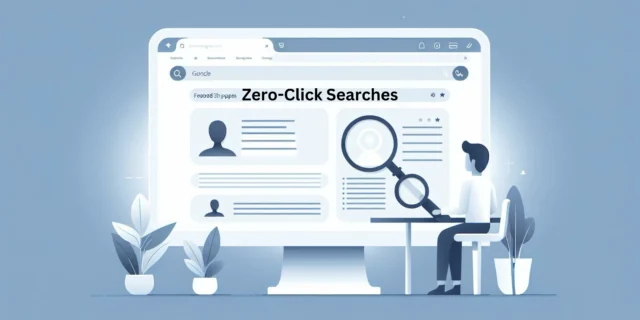Zero-click searches are becoming increasingly common, and understanding how to optimize your website for these searches is crucial for maintaining visibility and relevance in the digital landscape. A zero-click search occurs when users find the information they need directly on the search engine results page (SERP), without clicking through to a website. With Google prioritizing featured snippets, knowledge graphs, and other in-SERP content, businesses must adapt their strategies to ensure they still benefit from these searches.
In this blog, we’ll explore the key strategies for optimizing your website for zero-click searches, helping you capture visibility, traffic, and authority.

Table of Contents
Toggle1. Understand What Zero-Click Searches Are
A zero-click search provides the user with all the information they need without having to click on any of the links in the search results. Examples of this include:
- Featured snippets: Highlighted boxes that display answers to a search query.
- Knowledge panels: Informational panels that show up for branded searches.
- People also ask: A set of expandable questions related to the search query.
- Local packs: Maps and business listings that appear for location-based searches.
These elements provide users with quick answers but can reduce organic traffic to websites. Optimizing for zero-click searches ensures your content still ranks prominently, even if users don’t click through.
2. Target Featured Snippets
Featured snippets, also known as position zero, are one of the main components of zero-click searches. They provide a direct answer to a query at the top of the SERP. To optimize for featured snippets:
How to Optimize for Featured Snippets:
- Answer questions concisely: Structure your content to directly answer common search queries within the first 40-50 words of the page.
- Use headings and lists: Google favors content structured with clear headings (H2, H3) and bulleted or numbered lists.
- Provide clear and factual information: Ensure the content is accurate, well-researched, and easy to read. Avoid overly complex language.
- Use “how,” “what,” and “why” questions: Answer common search queries that start with these words, as they are more likely to trigger featured snippets.
By structuring your content to fit the featured snippet format, you can increase your chances of appearing at the top of the SERP for relevant queries.
3. Optimize for Local Searches and the Google Local Pack
For businesses that rely on local customers, zero-click searches often take the form of local packs, which appear in Google Maps or alongside the SERP in a box. Local packs show a list of businesses with ratings, hours, and directions, allowing users to get the information they need without clicking through.
How to Optimize for Local Pack Listings:
- Claim and optimize your Google Business Profile: Ensure your business profile is complete, with up-to-date hours, location, and contact information. Add high-quality photos and respond to reviews.
- Use local keywords: Include location-based keywords on your website, such as “plumbing services in Chicago.”
- Encourage customer reviews: Positive reviews help your business rank higher in local search results. Encourage satisfied customers to leave reviews on Google.
- Consistent NAP information: Ensure your Name, Address, and Phone number are consistent across your website and all online directories.
By focusing on local SEO and your Google Business Profile, you can maintain a strong presence in local search results, even if users don’t click through to your website.
4. Create Content for “People Also Ask” Boxes
The People Also Ask (PAA) box is another key component of zero-click searches. These boxes feature questions related to the original search query, offering quick answers from various websites. To optimize your website for PAA results:
How to Rank in People Also Ask:
- Use question-based keywords: Identify common questions your target audience is asking by using tools like AnswerThePublic or Google’s own autocomplete suggestions.
- Answer questions in your content: Within your blog posts or FAQs, answer relevant questions in a clear, concise manner.
- Structure your content with clear subheadings: Each subheading (H2, H3) should answer a specific question.
- Create FAQ sections: Adding FAQ sections to key pages on your site can help target the questions appearing in PAA boxes.
Ranking in People Also Ask boxes positions your content as an authoritative source while providing users with quick, useful answers.
5. Use Structured Data Markup (Schema)
Structured data, or schema markup, helps search engines understand the content on your website and display it in rich results. These rich snippets increase the chances of your content being displayed in zero-click search formats such as recipes, product details, or event listings.
How to Implement Structured Data:
- Use schema.org vocabulary: Implement schema markup for relevant content types, such as articles, FAQs, recipes, events, or reviews.
- Enhance product pages: Add structured data for product names, prices, availability, and reviews to help your product pages appear in rich results.
- Use FAQ and HowTo schema: If you have FAQ or step-by-step content, use specific FAQ or HowTo schema to increase the chances of your content appearing in featured snippets.
Structured data can significantly improve your website’s visibility in zero-click searches by making your content eligible for enhanced SERP features.
6. Optimize for Branded Searches and Knowledge Panels
A knowledge panel typically appears for well-known brands, people, or entities. These panels display a wide range of information, including an overview of the business, social media links, and related searches.
How to Optimize for Knowledge Panels:
- Claim your entity: Use Google’s Knowledge Graph to claim your business or brand’s entity. This allows you to manage the information that appears in the knowledge panel.
- Use consistent branding: Ensure that your brand name, logo, and descriptions are consistent across all platforms, including your website, social media, and directory listings.
- Build authority: Google uses authoritative sources to populate knowledge panels. Ensure your business is listed in relevant directories, news outlets, and Wikipedia, if applicable.
Optimizing for branded searches ensures that potential customers see accurate, comprehensive information about your brand directly on the SERP.
7. Focus on Mobile Optimization
A large portion of zero-click searches occurs on mobile devices, where users want quick answers without needing to click through multiple links. Ensuring your website is mobile-friendly is essential for appearing in mobile SERP features like featured snippets and local packs.
Best Practices for Mobile Optimization:
- Use responsive design: Ensure your website adjusts smoothly to various screen sizes and remains functional on mobile devices.
- Improve page speed: Mobile users expect fast-loading pages. Optimize images, minimize scripts, and leverage browser caching to improve performance.
- Create mobile-friendly content: Make sure your text is easy to read on smaller screens. Use short paragraphs, bullet points, and easily clickable buttons.
Mobile optimization not only enhances user experience but also boosts your chances of ranking in mobile search results and zero-click searches.
8. Provide Comprehensive and Authoritative Content
Google prioritizes high-quality, authoritative content for zero-click search results. To ensure your website ranks for zero-click features like snippets, knowledge panels, and PAA boxes, focus on creating content that is:
- Comprehensive: Provide in-depth, detailed answers that fully address user queries.
- Authoritative: Cite credible sources and ensure your content reflects expertise on the subject.
- User-friendly: Organize your content with headings, lists, and short paragraphs to make it easy to scan and digest.
By creating well-researched, user-centric content, you increase your chances of appearing in zero-click search results while building your site’s authority.
Conclusion
Zero-click searches are changing the SEO landscape, but they also present opportunities for businesses to enhance visibility and establish authority. By optimizing for featured snippets, local packs, People Also Ask boxes, and knowledge panels, and by implementing structured data, you can adapt to this trend and ensure your website remains a key player in search results. Keep focusing on creating high-quality, mobile-friendly content, and you’ll continue to capture attention—even in a zero-click world.


No responses yet